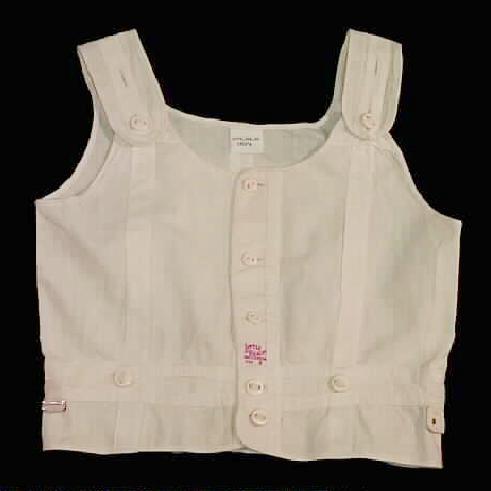
Vintage German Clothing: Underwaist with Shoulder Straps

Figure 1.--This American garment is a typical boy's underwaist with adustable shoulder straps to allow for the boy's growth. It buttons down the front and has reinforcement straps over the shoulder with taped-on waist buttons around the waist line so that short trousers or possibly knickers can be buttoned on.
|
|
This American garment is a typical boy's underwaist with adustable shoulder straps to allow for the boy's growth (figure 1). It buttons down the front and has reinforcement straps over the shoulder with taped-on waist buttons around the waist line so that short trousers or possibly knickers can be buttoned on. There are garter tabs at the sides with metal pinning tubes so that supporters for long stockings can be attached. These were standard garments for children during the 1920s for boys (and also girls) from about age 2 to age 12. Many of the girls' underwaists had lace or other adornments around the neck and often buttoned down the back whereas boys' underwaists were usually plain like this one and had front buttoning.
A reader writes, "I'm curious how this underwaist was supposed to work. If the boy wore a shirt over it, and the shirt was tucked in, how would the buttons reach the trousers? Was this designed to be worn with untucked shirts, such as middy blouses?" I am guessing that the boy might have worn button on shorts. The shorts buttoned on to the shirt. The buttons on the waisr might have been for garters to hold up ong stockings.
A HBC contributor provides even more information, "The reader's question is a good one. The waist buttons on waists served more than one purpose. If a boy buttoned his short trousers to the waist, he would have to wear a blouse-type outer garment that would come down over the waist or be tied at the waist
line to allow for blousing. A middy blouse was just loose at the bottom but still came below the waistline. If a boy wore a shirt that tucked into his short trousers, he would have to button the trousers to waist buttons on the shirt waist itself rather than on the underwaist. Shirt waists with buttons for short trousers were sold during the 1910s through the 1930s. But the buttons on the underwaist were also used for additional underwear such as underpants, panties, and bloomers (for
girls). Even girls who wore union suits, for instance, sometimes wore bloomers on top, which could then be buttoned to her underwaist or waist buttons on a taped union suit. Supporters for long stockings
were usually pinned onto the metal tubes or tape loops at the sides of the waist, but at earlier points (during the 1900-1910 period, for instance), supporters for stockings were sometimes buttoned on at the
sides. Most commerical hose supporters, however, were attached by safety pins, not buttons--at least after about 1910."
HBC

Navigate the Boys' Historical Clothing Web Site:
[Return to ther Main vintage clothing support garment page]
[Return to ther Main vintage clothing garment page]
[Return to ther Main German Leibchen page]
[Introduction]
[Activities]
[Biographies]
[Chronology]
[Clothing styles]
[Countries]
[Topics]
[Bibliographies]
[Contributions]
[FAQs]
[Glossaries]
[Images]
[Links]
[Registration]
[Tools]
[Boys' Clothing Home]
Created: 7:53 AM 7/26/2007
Last updated: 5:04 PM 7/26/2007


